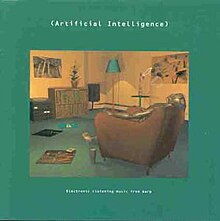Ambient techno
| Ambient techno | |
|---|---|
| Stylistic origins | |
| Cultural origins | 1990s, Europe |
| Typical instruments | Drum machine, synthesizer, sampler |
| Other topics | |
Ambient techno (also known as intelligent techno[1]) is an offshoot of techno and ambient house music that united the "soaring, layered, aquatic atmospheres" of ambient music with the melodic and rhythmic elements of techno and electro.[1] It was pioneered by 1990s electronic artists such as B12, Aphex Twin, the Black Dog, Higher Intelligence Agency, and Biosphere.[1]
History
The release of Warp Records' Artificial Intelligence compilation in 1992 helped to establish the genre and featured artists such Aphex Twin and B12 under aliases, Autechre, and the Orb's Alex Paterson.[2] Described by critic Simon Reynolds as a "post-rave genre," the style departed from the communal, dance-oriented sound of contemporary rave music and instead saw popularity as form of "electronic listening music."[2] Reynolds wrote:
With its samples of bird-song and trickling water, ambient techno is a digital update of the nineteenth century programme music – the pastoral symphony that is nary, as with the aqua-mysticism and forest idylls of Claude Debussy.[2]

Artists returned to the instruments of the Detroit techno and Chicago house scenes, including analogue synthesizers, the Roland 303 bass machine, and the TR-909 drum machine, while also drawing on ambient and chillout elements.[2] The style was associated with labels such as Warp, Apollo, GPR, and Beyond.[1]
